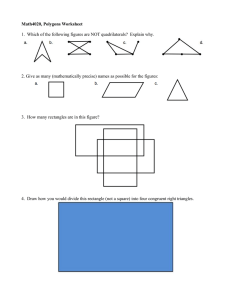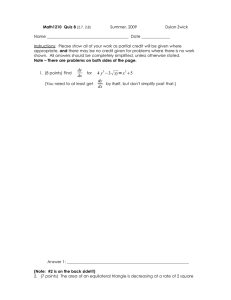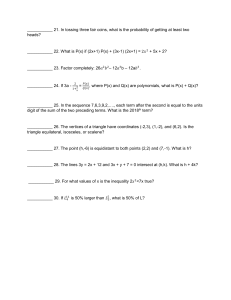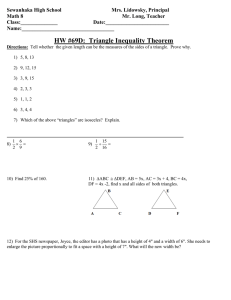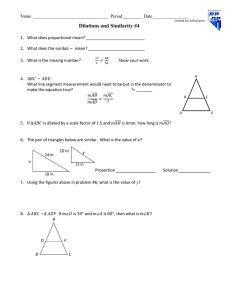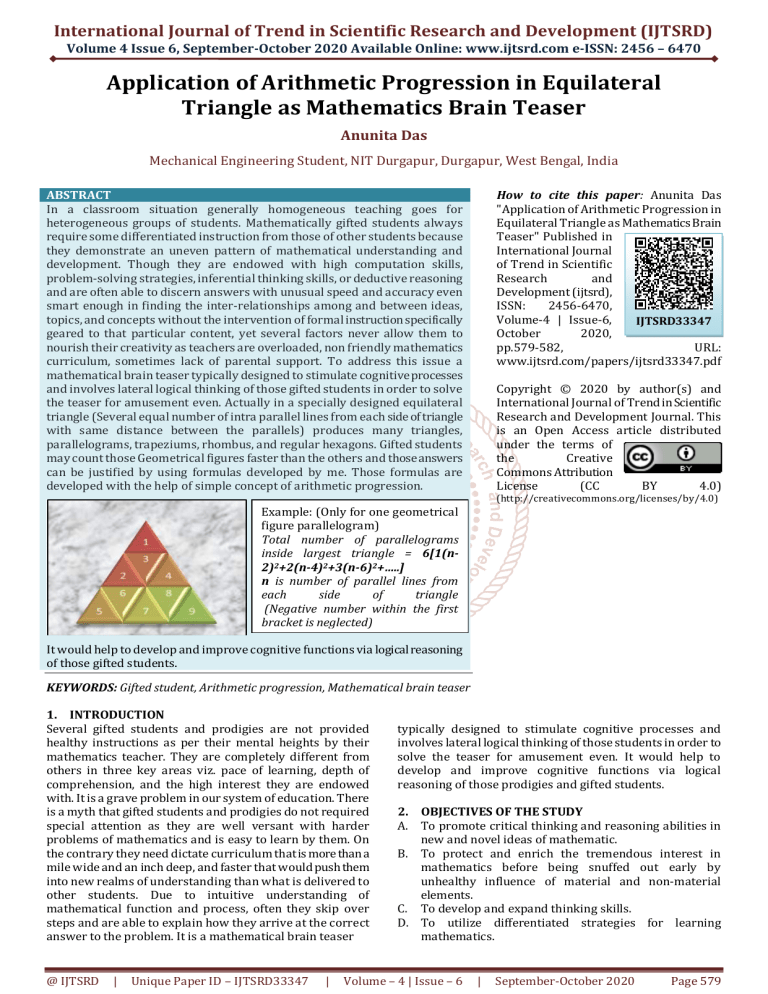
International Journal of Trend in Scientific Research and Development (IJTSRD)
Volume 4 Issue 6, September-October 2020 Available Online: www.ijtsrd.com e-ISSN: 2456 – 6470
Application of Arithmetic Progression in Equilateral
Triangle as Mathematics Brain Teaser
Anunita Das
Mechanical Engineering Student, NIT Durgapur, Durgapur, West Bengal, India
ABSTRACT
In a classroom situation generally homogeneous teaching goes for
heterogeneous groups of students. Mathematically gifted students always
require some differentiated instruction from those of other students because
they demonstrate an uneven pattern of mathematical understanding and
development. Though they are endowed with high computation skills,
problem-solving strategies, inferential thinking skills, or deductive reasoning
and are often able to discern answers with unusual speed and accuracy even
smart enough in finding the inter-relationships among and between ideas,
topics, and concepts without the intervention of formal instruction specifically
geared to that particular content, yet several factors never allow them to
nourish their creativity as teachers are overloaded, non friendly mathematics
curriculum, sometimes lack of parental support. To address this issue a
mathematical brain teaser typically designed to stimulate cognitive processes
and involves lateral logical thinking of those gifted students in order to solve
the teaser for amusement even. Actually in a specially designed equilateral
triangle (Several equal number of intra parallel lines from each side of triangle
with same distance between the parallels) produces many triangles,
parallelograms, trapeziums, rhombus, and regular hexagons. Gifted students
may count those Geometrical figures faster than the others and those answers
can be justified by using formulas developed by me. Those formulas are
developed with the help of simple concept of arithmetic progression.
How to cite this paper: Anunita Das
"Application of Arithmetic Progression in
Equilateral Triangle as Mathematics Brain
Teaser" Published in
International Journal
of Trend in Scientific
Research
and
Development (ijtsrd),
ISSN:
2456-6470,
Volume-4 | Issue-6,
IJTSRD33347
October
2020,
pp.579-582,
URL:
www.ijtsrd.com/papers/ijtsrd33347.pdf
Copyright © 2020 by author(s) and
International Journal of Trend in Scientific
Research and Development Journal. This
is an Open Access article distributed
under the terms of
the
Creative
Commons Attribution
License
(CC
BY
4.0)
(http://creativecommons.org/licenses/by/4.0)
Example: (Only for one geometrical
figure parallelogram)
Total number of parallelograms
inside largest triangle = 6[1(n2)2+2(n-4)2+3(n-6)2+…..]
n is number of parallel lines from
each
side
of
triangle
(Negative number within the first
bracket is neglected)
It would help to develop and improve cognitive functions via logical reasoning
of those gifted students.
KEYWORDS: Gifted student, Arithmetic progression, Mathematical brain teaser
1. INTRODUCTION
Several gifted students and prodigies are not provided
healthy instructions as per their mental heights by their
mathematics teacher. They are completely different from
others in three key areas viz. pace of learning, depth of
comprehension, and the high interest they are endowed
with. It is a grave problem in our system of education. There
is a myth that gifted students and prodigies do not required
special attention as they are well versant with harder
problems of mathematics and is easy to learn by them. On
the contrary they need dictate curriculum that is more than a
mile wide and an inch deep, and faster that would push them
into new realms of understanding than what is delivered to
other students. Due to intuitive understanding of
mathematical function and process, often they skip over
steps and are able to explain how they arrive at the correct
answer to the problem. It is a mathematical brain teaser
@ IJTSRD
|
Unique Paper ID – IJTSRD33347
|
typically designed to stimulate cognitive processes and
involves lateral logical thinking of those students in order to
solve the teaser for amusement even. It would help to
develop and improve cognitive functions via logical
reasoning of those prodigies and gifted students.
2. OBJECTIVES OF THE STUDY
A. To promote critical thinking and reasoning abilities in
new and novel ideas of mathematic.
B. To protect and enrich the tremendous interest in
mathematics before being snuffed out early by
unhealthy influence of material and non-material
elements.
C. To develop and expand thinking skills.
D. To utilize differentiated strategies for learning
mathematics.
Volume – 4 | Issue – 6
|
September-October 2020
Page 579
International Journal of Trend in Scientific Research and Development (IJTSRD) @ www.ijtsrd.com eISSN: 2456-6470
3. BODY OF THE WORK
Inside this largest equilateral triangle there
may be several smaller triangles, rhombus,
parallelograms, trapeziums and regular
hexagons. Students have to count it
traditionally first and the result may be
confirmed with the help of formulas. To obtain
those formulas the simple concept of AP was
applied. Where n= Number of parallel lines
from any base. And for this left side figure n= 3
(This can be extend).
Size of the equilateral triangle is flexible. Number of parallel lines from any base may be infinite, i.e. n = {1, 2, 3, 4 …∞}.
§ For triangle (
Equilateral)
Total number of triangles formed by adjacent 11, 22, 32, 42, 52,… triangle(s) shaping a triangle
n=10 (1+2+…+10)+2(1+2+…+9)+(1+2+…+8)+2(1+2+…+7)+(1+2+…+6)+2(1+2+…+5)+….+2(1)
n=9 (1+2+…+9)+2(1+2+…+8)+ (1+2+…+7)+2(1+2+…+6)+ (1+2+…+5)+ 2(1+2+3+4)….+1
n=8 (1+2+…+8)+2(1+2+…+7)+(1+2+…+6)+2(1+2+…+5)+(1+2+3+4)+….+2(1)
n=7 (1+2+…+7)+2(1+2+…+6)+ (1+2+…+5)+2(1+2+3+4)+(1+2+3)+….+1
n=6 (1+2+…+6)+2(1+2+…+5)+(1+2+3+4)+2(1+2+3)+….+2(1)
n=5 (1+2+…+5)+2(1+2+3+4)+(1+2+3)+2(1+2)+.…+1
n=4 (1+2+3+4)+2(1+2+3)+(1+2)+2(1)
n=3 (1+2+3)+2(1+2)+ 1
n=2 (1+2)+2(1)
Number of terms in that sequence = n
1. Total number of triangles inside the largest triangle = 2n3+5n2+2n (When “n” is even).
8
2. Total number of triangles inside the largest triangle = 2n3+5n2+2n-1 (When “n” is odd).
8
§ For rhombus (
considered only whose four sides are congruent)
Total number of rhombus formed by adjacent 2.11, 2.22, 2.32, … triangle(s) shaping rhombus
n=10 3{(1+2+3+….+8+9)+(1+2+3+…+6+7)+(1+2+3+4+5)+(1+2+3)+1}
n=9
3{(1+2+3+…+7+8)+(1+2+…+5+6)+(1+2+3+4)+(1+2)}
n=8
3{(1+2+3+…+6+7)+(1+2+3+4+5)+(1+2+3)+1}
n=7
3{(1+2+3+4+5+6)+(1+2+3+4)+(1+2)}
n=6
3{(1+2+3+4+5)+(1+2+3)+1}
n=5
3{(1+2+3+4)+(1+2)}
n=4
3{(1+2+3)+1}
n=3
3(1+2)
n=2
3(1)
Number of terms in that sequence = (n/2) when ‘n’ is even OR {(n-1)/2 when ‘n’ is odd
3. Total number of rhombus inside the largest triangle = n(2n2+3n-2) (When “n” is even)
8
4. Total number of rhombus inside the largest triangle = (n-1)(2n2+5n+3) (When “n” is odd)
8
§ For parallelogram (
considered only whose adjacent sides are not congruent)
For example the number of parallel lines from any base is taken here 7 (i.e. n=7). Here ‘R’ would be considered as rhombus to
form the parallelogram.
@ IJTSRD
|
Unique Paper ID – IJTSRD33347
|
Volume – 4 | Issue – 6
|
September-October 2020
Page 580
International Journal of Trend in Scientific Research and Development (IJTSRD) @ www.ijtsrd.com eISSN: 2456-6470
While counting
(parallelogram) form bottom to top from both left to right & right to left side
Between two // lines ( Left to right and
2(1+2+3+4+5) 2(1+2+3+4) 2(1+2+3) 2(1+2) 2(1)
right to left)
Under 2R
under 3R
under 4R
5R
6R
One line gap between two // lines ( Left to
2(1+2+3) 2(1+2) 2(1)
xx
xx
right and right to left)
under 6R
8R
10R
Two lines gap between two // lines ( Left to
2(1)
xx
xx
xx
xx
right and right to left)
12R
Total number of parallelograms counting
= 2(1+2+3+4+5) + 2(1+2+3+4) + 4(1+2+3) + 4(1+2) + 6(1)
from bottom to top
Hence total number of parallelograms (counted from three different sides of the triangle) = 3 {2(1+2+3+4+5) +
2(1+2+3+4) + 4(1+2+3) + 4(1+2) + 6(1)}.
(For 7 parallel lines there would be at least one parallelogram containing maximum 12 smaller sized rhombus)
In general,
5.
Total number of parallelogram inside largest triangle = 6[1(n-2)2+2(n-4)2+3(n-6)2+…..] (Negative number
within the first bracket is neglected)
§ For trapezium
For example the number of parallel lines from any base is taken here 7 (i.e. n=7). Here ‘T’ would be considered as adjacent
triangles to form the trapezium.
While counting
(Trapezium) from bottom to top
(1+2+3+4+5+6) (1+2+3+4+5) (1+2+3+4)
Between two // lines
under 3T
under 5T
under 7T
(1+2+3+4+5) (1+2+3+4)
One line gap between two // lines
xx
under 8T
under 12T
(1+2+3+4)
Two lines gap between two // lines
xx
xx
under 15T
xx
Three lines gap between two // lines
xx
xx
(1+2+3)
under 9T
(1+2+3)
under 16T
(1+2+3)
under 21T
(1+2+3)
under 24T
Four lines gap between two // lines
xx
xx
xx
xx
Five lines gap between two // lines
xx
xx
xx
xx
Total number of trapezium from
bottom to top
(1+2)
U 11T
(1+2)
U 20T
(1+2)
U 27T
(1+2)
U 32T
(1+2)
U 35T
xx
(1)
U 13T
(1)
U 24T
(1)
U 33T
(1)
U 40T
(1)
U 45T
(1)
U 48T
= (1+2+3+4+5+6) + 2(1+2+3+4+5) + 3(1+2+3+4) + 4(1+2+3) +5(1+2) + 6(1)
Hence total number of trapezium (counted from three different sides of the triangle) = 3{(1+2+3+4+5+6) +
2(1+2+3+4+5) + 3(1+2+3+4) + 4(1+2+3) +5(1+2) + 6(1)}
(For 7 parallel lines there would be at least one trapezium containing maximum 48 smallest sized triangle)
In general,
6. Total number of trapezium inside largest triangle = 3n(2n2-n-2) (When “n” is even)
8
7. Total number of trapezium inside largest triangle = 3(n-1)(2n2+n-1) (When “n” is odd)
8
§ For regular hexagon
For example the number of parallel lines from any base is taken here 11 (i.e. n=11). Here ‘T’ would be considered as adjacent
triangles to form the regular hexagon.
While counting
(regular hexagon) with
One line gap between two // lines
Three lines gap between two // lines
Five lines gap between two // lines
Total number of regular hexagon
6x11 smallest
6x22 smallest
6x32 smallest
triangles
triangles
triangles
(1+2+…..+9)
xx
xx
xx
(1+2+…..+6)
xx
xx
xx
(1+2+3)
= (1+2+….+8+9) + (1+2+….+5+6) + (1+2+3)
Hence total number of regular hexagon = {(1+2+….. +8+9) + (1+2+…+6) + (1+2+3)}
@ IJTSRD
|
Unique Paper ID – IJTSRD33347
|
Volume – 4 | Issue – 6
|
September-October 2020
Page 581
International Journal of Trend in Scientific Research and Development (IJTSRD) @ www.ijtsrd.com eISSN: 2456-6470
(For 11 parallel lines there would be at least six regular hexagon containing maximum 6x32 = 54 smallest sized
triangles)
In general,
8. Total number of regular hexagon inside the largest triangle = ½ [(n-1)(n-2)+(n-4)(n-5)+(n- 7)(n-8)+(n-10)(n11)+(n-13)(n-14)+………………...] (When “n” is a natural number) ( Negative number within the first bracket is
neglected)
9. Total number of regular hexagon inside largest triangle = n(n2-3) (When ‘n’ is multiple of 3)
8
4. DISCUSSION
All the geometrical two dimensional figures (i.e. equilateral
triangles, rhombus whose four sides are congruent,
parallelogram whose adjacent sides are not same, trapezium,
and regular hexagon) formed by parallel lines kept in equal
distance inside the largest equilateral triangle, can be
counted traditionally as well as by using the formulas. Those
formulas are deduced from the simple application of the AP’s
(Arithmetical Progression) formulas.
5. CONCLUSION
In secondary level mathematics class generally
homogeneous instructional practices are disseminated to
heterogeneous groups of students, their individual
characteristics, needs, abilities, and interest are personal and
unique. Mathematically gifted, prodigy, and savant are
always endowed with remarkable spectacular talent and
always reflect high computation skills, problem-solving
strategies, inferential thinking skills, or deductive reasoning
and are often able to discern answers with unusual speed
and accuracy. Essentially an effective basic curriculum for
those students who are mathematically gifted, prodigy, and
savant are to be developed to meet their needs. But several
factors never allow them to nourish their creativity as
@ IJTSRD
|
Unique Paper ID – IJTSRD33347
|
teachers are overloaded, non friendly mathematics
curriculum, sometimes lack of parental support. In order to
eradicate these problems a small effort is made to fulfill the
demands of that group under the title ‘Application of
arithmetic progression in equilateral triangle as
mathematics brain teaser’, which can be used according to
their pace, place and time.
REFERENCE
[1] Adler, A. and Coury, J. The Theory of Numbers, Jones &
Bartlett, Boston, 1995, p-321.
[2] E. R. Suryanarayan, The Brahmagupta polynomials,
Fibonacci Quarterly 34 (1996) p30to34
[3] http://www.treffertcenter.com
[4] hyperlexia3.com
[5] NCERT Class-XI mathematics
[6] R. D. Sharma Class-XI mathematics; Dhanpat Rai
Publication, 22, Ansari Road, Daryaganj. New-Delhi.
[7] StrokesofGeniusInc.org
[8] treffertcenter@agnesian.com
Volume – 4 | Issue – 6
|
September-October 2020
Page 582

